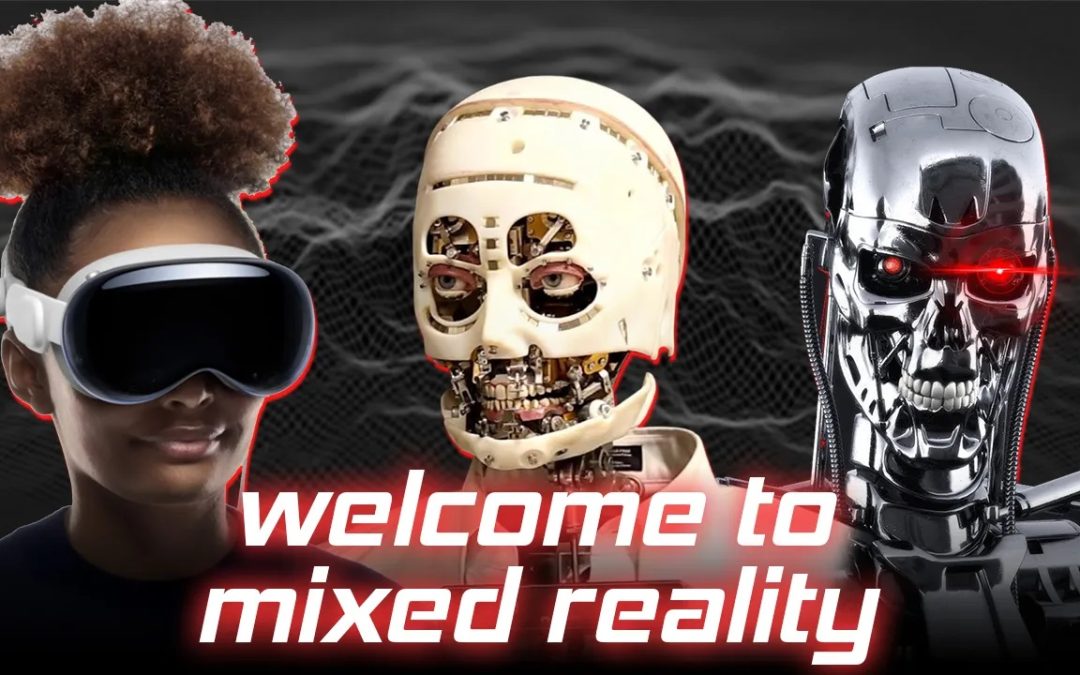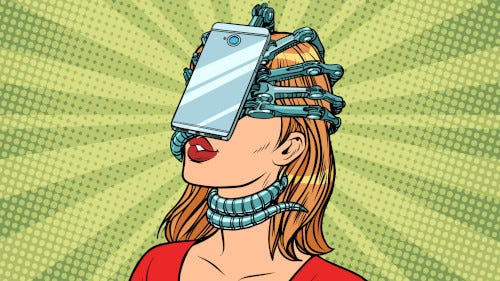Welcome to Mixed Reality:
A Fake Place Where Fake People
Are Trapped Forever
by James Corbett
corbettreport.com
“Once men turned their thinking over to machines in the hope that this would set them free. But that only permitted other men with machines to enslave them.”
– Frank Herbert
The worst thing in the world is to be right.
No, that’s not quite right. Let me amend that. The worst thing in the world is to be right about something horrific and inescapable, a looming danger that you can see approaching from the distance but whose progress you are powerless to prevent no matter how loudly you ring the alarm.
This is the lesson of Cassandra, the Trojan princess of Greek mythology who, having deceived the god Apollo, was cursed with the gift of uttering true prophecies that were never believed by anyone.
And, agonizingly, it is also the lesson I have had the displeasure of learning through personal experience during my 17 years of creating The Corbett Report.
I produced podcasts warning about transhumanism and technocracy before most people even knew what a podcast was.
I filed a report on Medical Martial Law in 2009, back when quarantines and forced vaccinations were treated as the far-out fantasies of Hollywood script writers.
And in 2021 I warned about the coming of the next stage of The Media Matrix: the metaverse.
Now, here we are in 2024, and, once again, the general population is just starting to catch up with what we Corbett Reporteers have seen coming for years.
So, are you ready for the horrors of an always-on, constantly connected, interminably intermediated “mixed reality”?
No, of course you aren’t. Here’s why.
VISION PRO
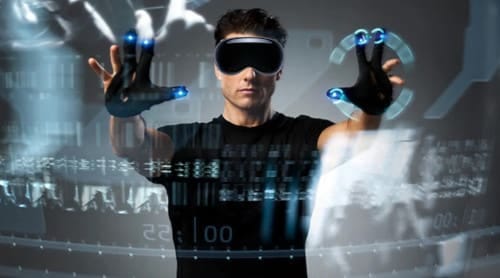
Have you encountered one in the wild yet? You know, a real, live Vision Pro wearer?
Maybe not. But, chances are, you will soon enough.
For those not in the know, Vision Pro is the sexy new $3,500 mixed-reality headset from the same bitten-Apple gadget porn designers who brought you the iPhone and the iPod and the iWatch and a seemingly never-ending assortment of Chinese slave-made fondleslabs and digital doohickies.
The Apple Vision Pro—the latest object of fetishistic devotion from the wizards of Cupertino—is being marketed as “an infinite canvas that transforms how you use the apps you love” and as an “introduction to the era of spatial computing.”
So, what does this commercial claptrap really mean? What does a “mixed-reality headset” actually look like?
Well, like this, of course:

If this is your first time seeing the Vision Pro in use, you would be forgiven for concluding that we are experiencing an invasion of transhuman cyber-soldiers. But don’t worry, it’s not that. It’s just the beginning of the dystopian cyberpunk horror film that is the world of 2024.
Anyway, you can go to the Apple site and watch the promotional materials to learn all about this new technological marvel and how it will soon change all our lives for the better . . . but you don’t need to do that. You can just read one of the many, many, many, many, many, many “news articles” (read: advertisements) for the gadget that have been generated in the dying dinosaur media of late.
“WATCH: Man in Apple Vision Pro headset crosses street, officers pause ‘in bewilderment,’” reports Fox 5 San Diego.
“Stop Wearing Vision Pro Goggles While Driving Your Tesla, U.S. Says,” The New York Times informs its readers (while subtly implanting the idea that this new gadget is so awesome you’ll literally never want to take it off).
“I lived inside a Vision Pro for two weeks. Here’s what it was like,” gushes Chris Velazco, the hard-hitting, no-nonsense, definitely-not-compensated-by-industry tech reviewer at The Washington “Democracy Dies in Darkness” Post.
And yet, despite how incredibly NEW AND EXCITING all of this “mixed reality” Vision Pro hype appears to be . . . doesn’t it seem vaguely familiar?
Well, it should seem familiar. And I’m not just saying that because I predicted it in my Things That Will Absolutely, Definitely, No Doubt Happen in 2023 article at the beginning of last year
That’s right! Everyone loves their phone . . . and now their phone can love them back! And they’ll never have to worry about forgetting their phone at home ever again!
(Ahhh, satire!)
No, this should seem familiar because you almost certainly saw it (or at least the COOL AND EXCITING gestural interface the Vision Pro relies on) in that 2002 summer blockbuster, Minority Report. In reality, Minority Report was not just a COOL AND EXCITING! action flick from Steven Spielberg and Tom Cruise, but a masterclass in predictive programming. For years afterward, everyone was citing every disturbing new technological “advancement”—from the creepy digital marketing billboards that could identify you by eye scan and address you personally by name to the amazing gestural technology that allowed Cruise (as Detective John Anderton) to waltz his way through oceans of digital information like a composer conducting a symphony—as an example of a Minority Report-style dystopia coming into view.
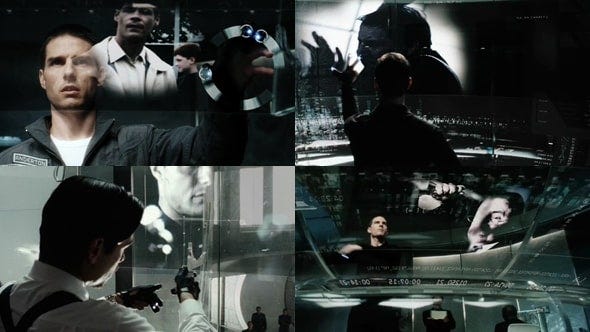
Well, in case you didn’t know, Minority Report‘s amazing ability to predict the future was no mere happenstance. In fact, Minority Report was a textbook example of predictive programming, in which we were inoculated against our current-day invasion of Vision Pro-wearers by witnessing it all on the silver screen before it came to pass in reality.
As I reported 12 years ago in PSYOPS 101: The technology of psych warfare:
Minority Report is a 2002 Hollywood sci-fi movie from director Steven Spielberg presenting a dystopian future of pre-crime, total surveillance and police state technology. Unlike many science fiction fantasies, however, the technology depicted in the film has already proven remarkably prescient. From statistical analysis programs like IBM’s Blue CRUSH that purports to be able to predict criminal “hotspots” to drone technologies that are beginning to look more and more like the police tracking robots depicted in the movie, Minority Report has proven time and again to have been ahead of the curve in predicting technology. This is not accidental. During the film’s pre-production in 1999, Spielberg invited a panel of experts to a three-day “think tank” in Santa Monica, California. Including architects, biomedical researchers and computer scientists, the group wrote the “2054 bible,” an 80-page book detailing the most likely technological, sociological, architectural and political changes of the next half-century.
That’s right! The wizards of Holy/Wood and their scriptwriting sorcerers actually convened an ad hoc “think tank” to write a bible of the future, in which they boldly “predicted” what our world would look like in 50 years. And that ragtag bunch of young up-and-comers—including the corpulent, Hillary-worshipping Jaron Lanier of The Social Dilemma fame and Shaun Jones of DARPA biowarfare infamy and Steward Brand of Whole Earth Catalogue notoriety—just happened to put together a movie that depicted a number of future technologies (like the gestural interface technology that is now creeping out random passersby on the street in New York and other tech-enslaved hotspots) with eery accuracy.
Funny how that works, isn’t it?
Here are the real questions: Why are the Holy/Wood magicians and the news repeaters and the tech giants and seemingly everyone else in positions of power so invested in getting us to strap a computer to our face? What is this tech takeover really about? And how is this technology going to start changing us as a species?
A FAKE WORLD FOR FAKE PEOPLE
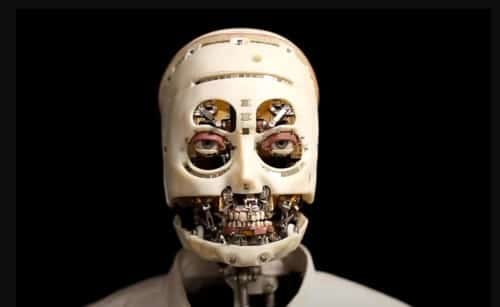
The scenes of Vision Pro-clad transhumans walking around our cities is nightmarish enough. Merely watching these not-quite-here people trying to interact with their fake online digital spaces at the same time as they’re navigating crosswalks and driving cars is anxiety inducing in itself. But what does it look like from their perspective?
Once again, as a clued-in Cassandra of The Corbett Report community, you will already know the answer to that question. Specifically, you’ll be able to cast your mind back to Lesson 3 of the Mass Media: A History online course (“Caught in the Web”) in which we experienced “hyper-reality“—the immersive simulation of the augmented reality of the future originally developed in 2009 by filmmaker Keiichi Matsuda as part of his master’s thesis at the Bartlett School of Architecture in London.
Viewers of that non-stop assault on the senses will no doubt remember how incredibly overwhelming that imaginary experience in a “mixed reality” environment is at first, with an ordinary bus trip . . .
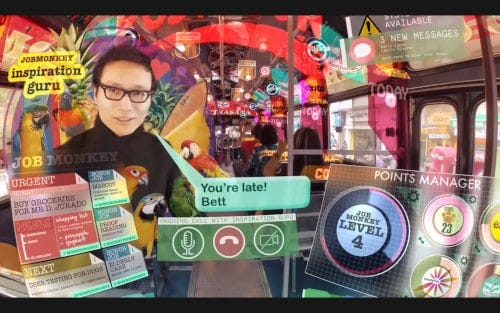
. . . and an ordinary shopping trip to the grocery store

. . . being transformed into a kaleidoscopic eyegasm of information, messages, advertisements and activities, all displayed for the film’s first-person protagonist (Juliana Restrepo) on a display presumably being projected into her eyes by a Vision Pro-style headset in some near-future setting.
But you will also remember that gut-dropping moment when the protagonist’s headset comes under cyberattack and she is forced to reboot her system, revealing the bare, boring, non-hyper-reality underlying the frenetic visual display on her device.

What makes Matsuda’s film so powerful is that it demonstrates not only what the world might look like for those who choose to strap themselves into the mixed-reality nightmare of the Big Tech overlords, but also how utterly addictive such an unreality can become even after a few short minutes of exposure. The revelation of the simple, unadorned supermarket aisle in all its drab reality is a gut punch to those viewers who didn’t even realize they were already starting to get drawn into the digital matrix being overlayed on the screen.
As I say, if you did take the online mass media history course and you did get through Lesson 3, then you experienced this moment for yourself, and you already know it to be true. But, in case you’re one of those people who can believe something only when it’s confirmed by third parties, here’s your confirmation:
“Beware: The Apple Vision Pro may rewire our brains in unexpected ways”
That’s an article by Adam Rogers at BusinessInsider documenting an experiment conducted by a team of researchers led by Jeremy Bailenson at the Virtual Human Interaction Lab at Stanford. In that experiment, subjects attempted to wear an Apple Vision Pro or a Meta Quest (Zuckerberg’s Facebook equivalent of the mixed-reality goggles) for weeks at a time, and the results were shocking. As it turns out, the “passthrough” process by which these devices take the real world and then present it to its wearer via the digital screen begins to have profound dissociative effects on the gadget’s user after prolonged periods of use.
Because passthrough captures and then re-renders reality, it can have an unnerving, distancing effect over time. When Bailenson’s colleagues actually tried to talk to people, the world turned into a giant, confusing Zoom. Video chats, as we’ve all experienced, are plagued by delays in responses and missed social cues. Conversations lose subtlety, but it’s good enough for a meeting. But passthrough magnifies the effect — the people you talk to start to seem unreal. Up close, they look like avatars. Farther away, they become just part of the background.
In other words, the difference between the digital world and the “real” world starts to blur. The digital world may seem more “real” but only at the expense of the “real” world losing its sense of reality.
So, what is the end result of such a process?
Do we begin to lose our cognitive faculties altogether?
Do we start to imbue the machines and bots and algorithms and avatars that form the fabric of this mixed-reality universe with humanity?
And, most worryingly of all, do we forsake our humanity altogether by engaging in this fake digital world? That is to say, if we continue to follow this path—if we strap on the goggles and literally immerse ourselves in the Media Matrix—do we start to become machines?
NOW, LAUGH AT CASSANDRA, AS YOU HAVE BEEN PROGRAMMED TO DO!

If you don’t know how these long-term social engineering programs work yet, let me clue you in. It’s at this point that the narrative controllers put out some sort of “news” story that elicits laughter at the Cassandras warning about the looming catastrophe. Soon, everyone will be relentlessly mocking anyone who sees any sort of threat from the mixed-reality dystopia.
Don’t believe me? Well, think back to when the term “metaverse” was first seeded in the public consciousness a few years ago. Do you remember how the term immediately got hijacked by Mark Zuckerberg? And how our first impression of the metaverse was the clunky, Facebook version of that virtual space? Now the very word “metaverse” is a running gag about bad branding decisions and silly-looking avatars and whoever warns us about the dangers of immersing ourselves in these digital spaces of the future is dismissed like Cassandra.
“Pfff. James was warning us about this metaverse stuff a few years ago, but look how wrong he was! It was all a bunch of fluff and hype, and it never caught on. Now excuse me while I strap on my Vision Pro.”
Of course, you can guess what the latest headlines about the Vision Pro are telling us. That there’s nothing to worry about! That the Vision Pro hype was all just a silly two-week trend and, thank goodness, it’s all over now!
Observe: “Apple Vision Pro users begin returning headset, blaming headaches and limited uses.”
You see? Relax, everybody. These goggle thingies are cumbersome and uncomfortable, and people are already returning them. End of story.
If this is your first rodeo, here’s how this scam works: these “people are returning their Vision Pro” reports, too, are just another part of the extended dinosaur media advertising campaign that is seeking to ease us into the media matrix.
Now, don’t get me wrong: this is not an advertising campaign for the Vision Pro in particular. It’s a campaign to convince us this “mixed-reality” nonsense (or whatever they’re calling it this week) is part of our day-to-day reality now. It’s inevitable. It’s hear to stay. Get used to it. Or at least get used to seeing people using it, because, as it turns out, this is all an aspect of the “mimetic desire” phenomenon that will eventually lead to us adopting this technology. (Remember when Stephen Colbert took a bizarre break at the 2010 Grammy Awards to show off his spiffy new iPad to the TV-addicted masses?)
The point of this new “everyone is returning their Vision Pro!” news story advertisement is to plant the idea in the public consciousness that our unease with this latest technology is understandable. After all, at this stage the technology is clunky and headache-inducing. But the headlines are simultaneously planting the idea that these contingencies of form are the only reason people aren’t lining up around the block to strap themselves into the goggles right now. Once someone cracks the design code and makes glasses that are comfortable and stylish, then the social engineers will have removed the one obstacle to this technology that they have allowed us to recognize.
And then, when people begin inserting themselves into the “mixed-reality” media matrix . . .
. . . well, unfortunately, my fellow Cassandras know all too well how the rest of the story plays out. Let’s just hope that Apollo’s curse is not upon us so we can successfully warn the masses before it’s too late.
Like this type of essay? Then you’ll love The Corbett Report Subscriber newsletter, which contains my weekly editorial as well as recommended reading, viewing and listening. If you’re a Corbett Report member, you can sign in to corbettreport.com and read the newsletter today.
Not a member yet? Sign up today to access the newsletter and support this work.




